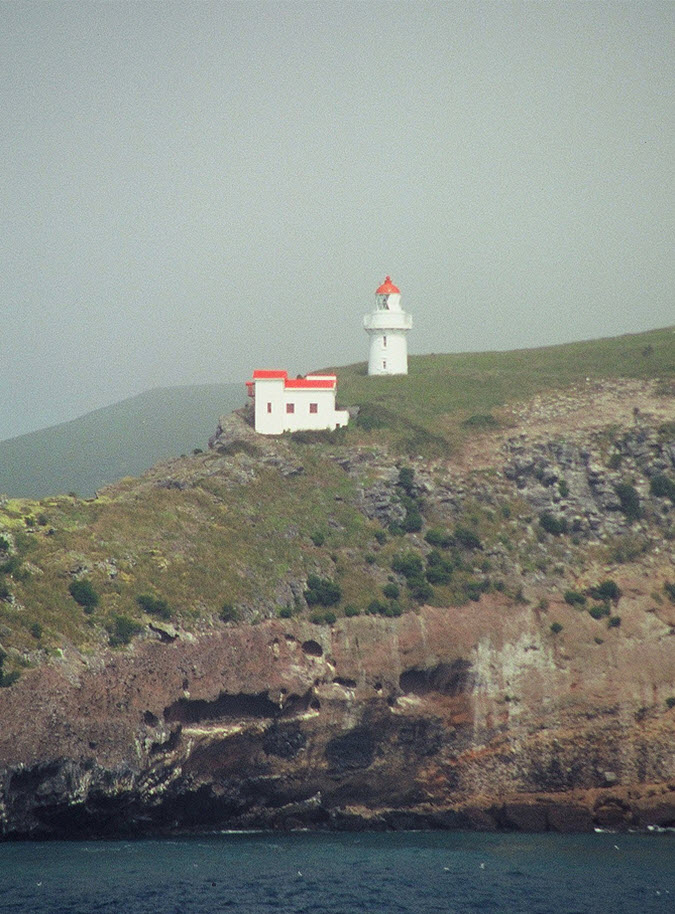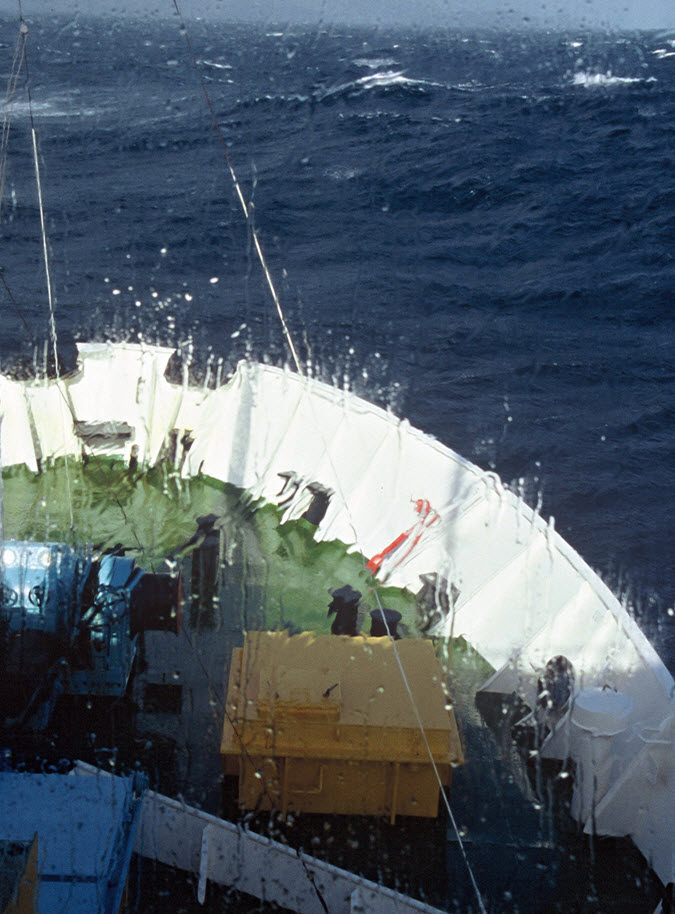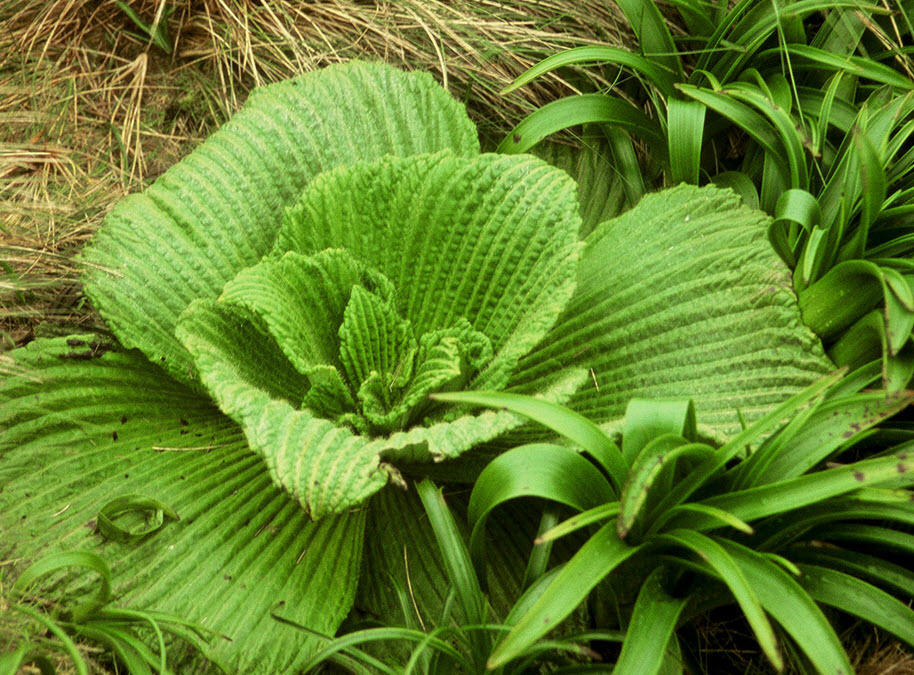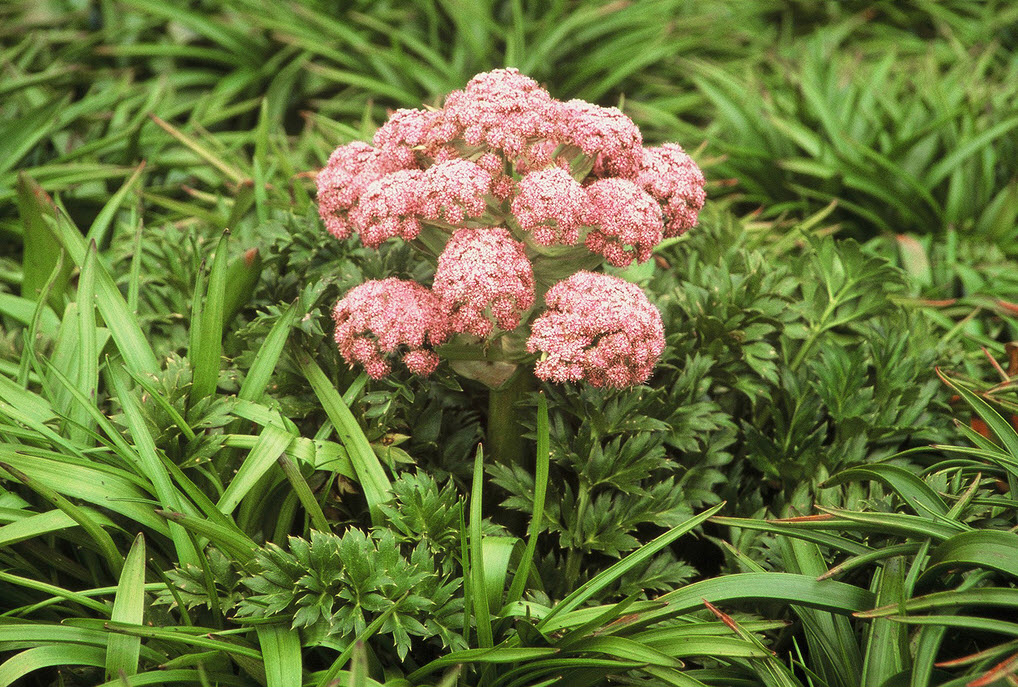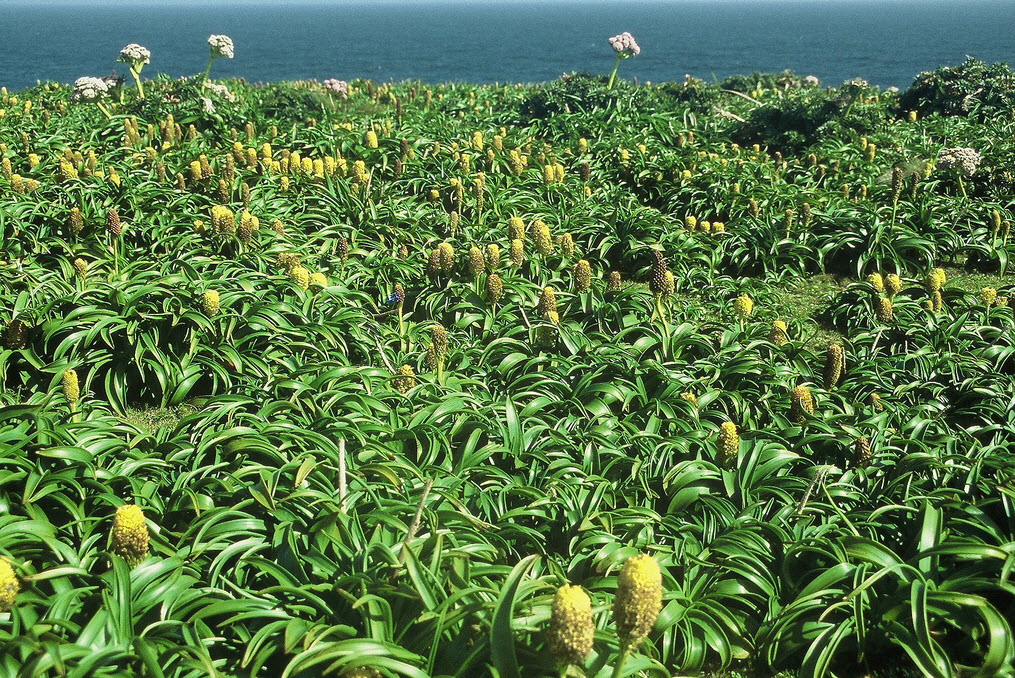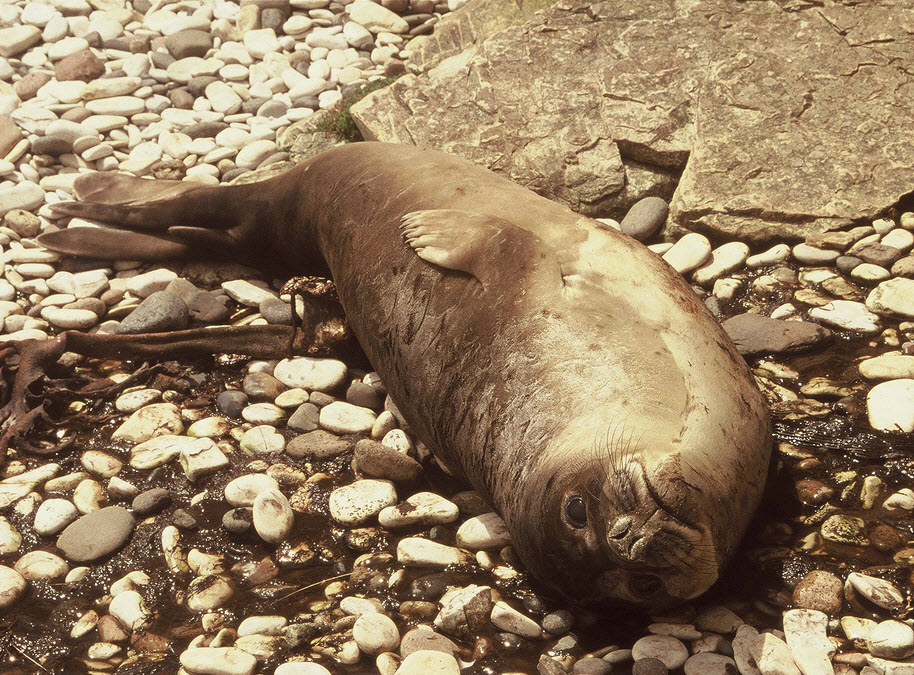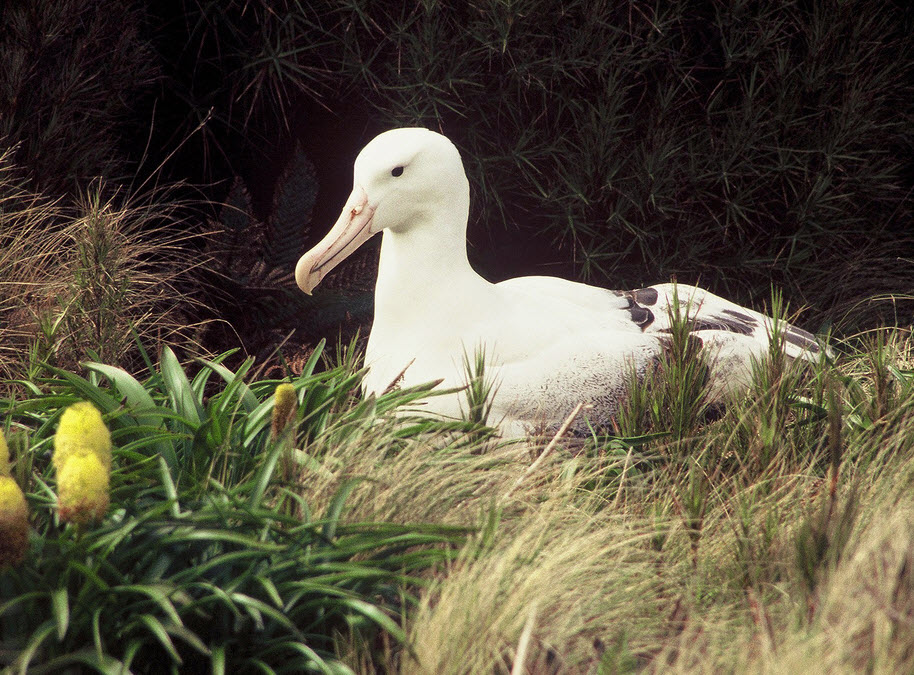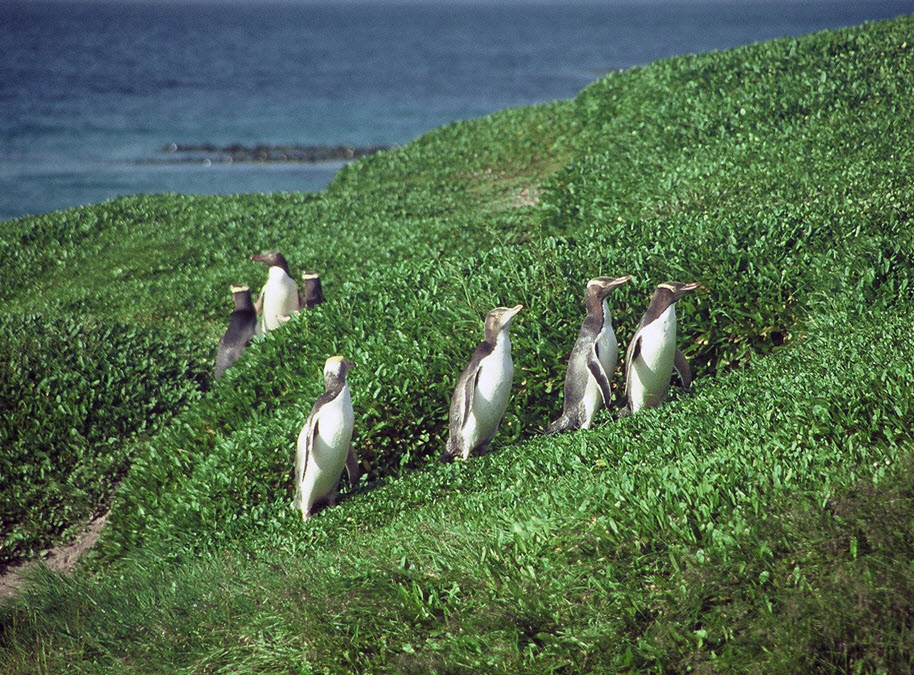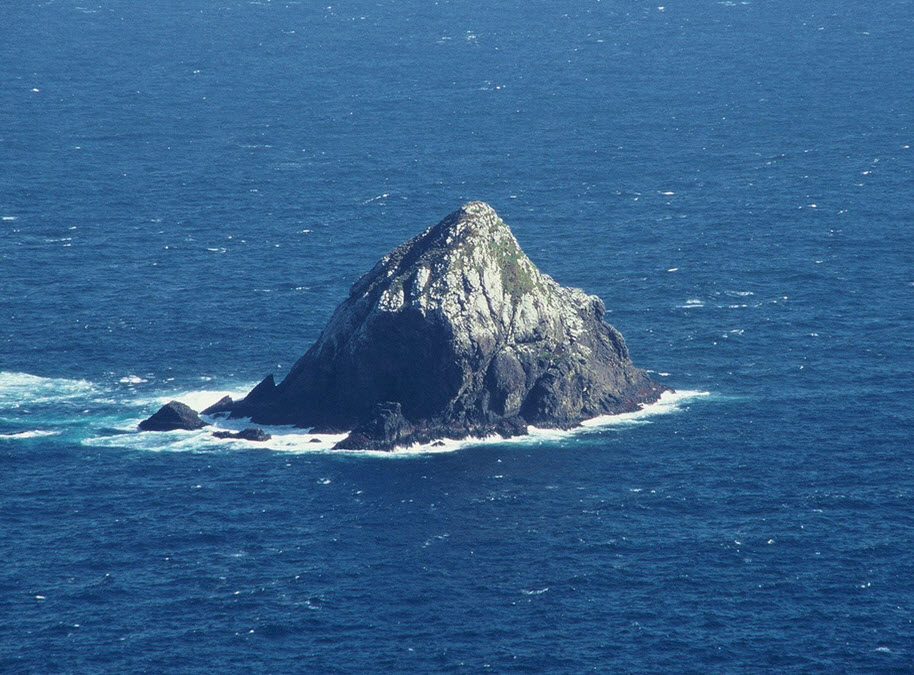Our ship the Akademik Shokalskiy at anchor in Perserverance Harbour – the island was uninhabited when we arrived – We left behind two staff from the NZ Department of Conservation who were setting the place up for an ambitious (and eventually successful) rat eradication program
Images and story by Mark Fountain
Mark Fountain is a denizen of Tasmania (the large island below Australia). When Mark first wrote this article in 2000 he was Horticultural operations manager at the the Royal Tasmanian Botanical Gardens, in 2016 he is now the Deputy Director of the Gardens.
Mark has had a major involvement in the development of a Subantarctic Plant House at the gardens and has consequently dreamed for many years of visiting these wind blasted islands. An official Australian Antarctic Division attempt to visit Macquarie island several years ago failed at the last moment due to a minor medical problem (slight valve bounce). So when a second (less medically heartbreaking) opportunity came to make a more extensive trip with the New Zealand eco-tourism operators Heritage Expeditions, it was embraced with exuberant alacrity. On December the 11th. 2000, he boarded the converted Russian ice breaker the Akademik Shokalskiy departing from the southern New Zealand port of Dunedin. The trip was to include landings on subantarctic: Campbell, Macquarie, Enderby and Auckland Islands and a close up viewing of the Snares island group from small boats. As a horticulturist and field botanist his focus is on all things with chlorophyll, but as is obvious from these travel notes from Campbell island, the animal and bird life was undeniable and overwhelming.
Over two weeks in December 2000 I was lucky enough to travel to several of the New Zealand and Australian subantarctic islands. This trip was proposed, encouraged and facilitated by our grant partners the University of Queensland (and paid for through the Australian Research Council SPIRT grant we share with the UQ and the Australian National Botanical Gardens.
All the islands were truly remarkable, each island with it’s coterie of lowering grey meteorological hangers-on had a strangely powerful presence. I’ve tried to document my short experience with each island in as much detail as possible in the hope that this might reveal something of the wonder these places hold.
We left Dunedin on the 11th of December and headed into the Southern Ocean, we had what the tour crew called moderate to rough conditions for most of the trip. A significant number of people retired to their bunks only to appear on reaching an island, others attempted cameo appearances at meal times. Unbelievably, and contrary to all my expectations I reveled in the entire experience. For many reasons I had not expected to be at all comfortable wallowing around on the ocean 100s of ks away from plant life, as it was I spent many hours on the bridge enjoying the ocean and exhilarated by wave topping albatrosses.
Campbell Island
We arrived at Campbell island on December the 13th, entering Perseverance harbour very early in the morning. A strong chattering headwind funneling down the valley, a few rare yellow eyed penguins porpoising alongside, albatrosses doing their slow motion wheel whatever the wind or weather and ahead mist and cloud hiding and revealing the landscape at almost shutter like speed.
It’s a strange feeling arriving on a body of land populated only by animals and birds. We landed at the old base, my horticulturists eye already sorting the plants into known and unknown and categorising the unknown into varying levels of mystification. The first part of the walk took us around the last few bays of the harbour, each guarded by a testosterone charged sub-adult male (SAM) Hooker’s Sea Lion. These males-in-waiting are usually a few years away from the reproductive furore of the main breeding colony on Enderby island and roam widely on Campbell island, testing their territorial skills and hoping to encounter an uncontested female. They can occasionally move towards you in a fairly convincingly aggressive show of bluff. We also skirted around several nests containing huge Giant Petrel chicks whose protective mechanism is to projectile vomit foetid stomach matter over those who come too close.
Once through the wild animal gauntlet (except for the occasional SAM) we climbed across the heathlands and through a couple of small depressions forested with 4-5m tall multi-trunked, moss covered Dracophyllums and from then up through grasslands to the edge of the spectacular cliffs overlooking North-West bay. Constant shifting and lifting mists revealed the scale of the bay below. The cliffs are the remnant rim of a large caldera with the jagged tooth shape of Ile La Dente (now called more pragmatically Dent Island) as an iconic focal point.
The impacts of humans and human introductions onto the island (sheep and some cattle, rats, and fire) means that in some cases the more sensitive flora has been reduced to refugial populations, the exposed cliff top edges seem to have provided this sort of niche for the extraordinary megaherbs. These can be almost tyre-sized rosettes of intricately corrugated leaves, creased with origami like precision in the case of Pleurophyllum speciosum or the large dissected leaves and enormous pink broccoli (although actually belonging to the Carrot family), like flower heads of Anisotome latifolia.
On the other hand, the red hot poker sized lily Bulbinella rossii, which it is not palatable to stock and has a persistent underground tuber has expanded it’s range. The reduced competition allowing it to colonise quite extensive areas, possibly shared in the past with megaherbs or dominated by the islands larger grasses. The large yellow flower spikes of the Bulbinella provide constant flecks of colour across the otherwise nearly monotone landscape. These plants combine into megaherb gardens which coupled with their spectacular cliff top eyrie and the illusory backdrop of North West Bay created by the mist and a seemingly exaggerated sense of the curvature of the earth form one of the most unique plant vistas I’ve ever had the privilege to gaze over.
Most subantarctic megaherbs tend to mast flower (flower en masse cyclically approximately every 3 years) and had flowered spectacularly in the previous year so the Pleurophyllums in particular were unfortunately mostly devoid of flower.
The walk continued along the cliff downwards towards some rocky beaches with views from the back of the cliffs over the minimalist landscape of the interior and towards the almost identical mounds of The Menhir and Mount Paris. After members of the party had been chased downslope by a young Sea Lion experimenting with his power to induce fear, we walked onto a rocky beach, stepping over a young elephant seal weaner. The beach also played host to some equidistantly (not quite within fighting distance) spaced Hooker’s Sea Lion Beach Masters-to-be, who along with several sea lion cows appeared to be forming small proto-harems. Towards the rear of this rocky beach two huge sea elephant cows lolled on thick mats of the Button Daisy, Leptinella plumosa and in the corner of the beach lay the carcase of a Leopard Seal, the streamlined shape of this predator still readily apparent.
Campbell island is the most important breeding location in the world for the Southern Royal Albatross and as we walked back inland, we traversed the slopes of Mount Dumas which seemed to have the highest concentrations of these very big and very beautiful birds. Looking across the slopes from a distance the nesting birds were highly visible, like white cut-outs exposed amongst the pale grey/green/straw colour of the Poa tussocks, others wheeled overhead in graceful, decisive arcs. My memory is of primal almost pterodactyl like calls being carried on the wind. Up close, the birds are perfectly proportioned giants. We were lucky enough to be able to sit quite close and observe courtship and greeting rituals. It’s not easy to convey the size of these birds, it’s a case of seeing is encompassing – for example, a bird sitting on the nest would be half way up the average persons thigh and their heads might be approximately 30 cm from the back to the end of the beak.
Dropping down from the Mnt. Dumas foothills we passed through exposed cushion heathlands and grasslands. Amongst the plants encountered in the grasslands environment were the surprising domes of the clubmoss Huperzia varia growing amongst tussocks of Poa litorosa. Other intriguing discoveries were the small orchids Chiloglottis cornuta and a Corybas sp. as well as two different species of the tiny finger fern Grammitis. Two familiar cushions were Phyllachne colensoi which also grows in Tasmania and Oreobolus, different species of which are encountered in Tasmania’s highlands.
We could see the Akademik Shokalskiy anchored in the distance and occasionally lit by beams of light breaking through the fine mist-like clouds streaming over Mount Honey. Trekking back towards the ship we passed the Worlds Loneliest Tree (according to the Guiness Book of Records), an obdurate many branched spruce, struggling to reach tree status. The tree, now guarded by a very possessive sea lion had been planted during the short, ill-considered attempt to establish a farm on the island.
Next Morning
Perseverance harbour and environs was an ambient and suitably subantarctic grey and Mnt.Honey, the target of one of two planned walks was shrouded in cloud. The tour leaders opted for an extended version of a walk up to the Col Lyall ridge and beyond to again look over North West Bay, this time from a different more northerly aspect.
The first part of the walk took us through the old base, now being made habitable by two staff from New Zealands Department of Conservation who had arrived with our ship and were setting up for a logistically massive attempt to eliminate rats Ratus norvegicus from the island. (Rats have had significant impacts on nesting birds -especially burrowing or flightless birds, common characteristics of many birds from NZ islands – and in the case of Campbell have been partially responsible for driving two small ground dwelling birds, a flightless teal and a snipe to the point were they were considered extinct until re-discovered on tiny nearby, rat free, Ile La Dente).
I spotted some rather mega-sized dandelions and several other weeds near the base, further examples of man’s feral legacy, although, fortunately in this case they still seem to be confined to the areas in and directly surrounding the base. A duckboarded track led through the base and into a low (up to 3m) thicket of Dracophyllum, a small number of these stout, many branched, shrubs were encrusted with a large, thick, rubbery, lichen which was coloured an almost unnatural, radioactive, duck-egg green . As the thicket opened out the occasional Pleurophyllum criniferum began to appear. We had seen some small specimens on the previous day but nothing to compare with these out of scale herbaceous plants, their size making them appear illogical and dream like. The pale grey/green, papery leaves were informally and very shallowly rippled as opposed to the precise and angular geometry of Pleurophyllum speciosum. The articulated silver ghosts of last seasons metre long flower spikes lay amongst the plants.
In contrast to the outsized Pleurophyllum a number of fingernail sized orchids flowered boldly but were barely visible along the edges of the path. Hands and knees were needed to view the minute, nearly transparent flowers of the antarctic beak orchid, Lyperanthus antarcticus.
A distinctive feature of New Zealands shrublands is the high percentage of divaricating plants. This physiological adaption is characterised by dense, obtusely angled branching and helps create the pruned/sculpted appearance of the shrubby heathlands on the island. The low heathlands on Campbell island are dominated by Myrsine divaricata and Coprosma species. Divarication is probably an adaption to environmental conditions, especially extreme winds and is possibly also attributable to grazing animals (some scientists blame the now extinct giant flightless bird, the Moa).
From this point we could see two sites of historical significance on the island, the collapsing remains of the coast watchers hut was barely visible at the base of a short rise. The hut had been manned constantly during the Second World War when both Perseverance harbour and Carnley Harbour on Auckland island were perceived as being possible points for hiding and massing large fleets. Paradoxically and more importantly the coast watchers became the islands first naturalists and were instrumental in gaining recognition for the islands as places of ecological significance.
The other historical site was a discernible line created by the regeneration of the grasslands and herbfields on the northern side of a now nonexistent fence used to restrict the remaining sheep to the southern section of the island. With the removal of sheep (and the fence) from the entire island in 1991 this grass formed ecological demarcation zone is now starting to blur. Patches of megaherbs and the larger palatable grasses, Chinochloa antarctica and Poa foliosa are rapidly beginning to recolonise. Here protected from the westerlies, the megaherbs, especially Pleurophyllum speciosum and P. criniferum were reaching their maximum dimensions.
Somehow in this otherwise flowerless season one Pleurophyllum speciosum flowered conveniently close to the track, it’s large, classic daisy flowers in a rich purple, made even more flamboyant by the pared down straw/grey of the surrounding landscape. This was hardly matched by the one, small, albatross-trampled, Pleurophyllum hookerii flower viewed the previous day, and a single P. criniferum flowerhead of battered black buttons spotted later in amongst the buildings at the base.
In the distance an extensive field of the pale straw-coloured tussock grass Chinochloa antarctica monopolised a sheltered bowl which reached from under the lee of the north western cliffs and the southern slopes of Mount Azimuth, to the edge of north east harbour and included most of the interior of the northern section of the island. Looking east under the very blackest of storm clouds, a single blinding, biblical shaft of intense sunlight lit the entrance to north east harbour.
The sense of walking
up to the edge
of what was once
a volcano.
At this point in the walk, an implicit sense of what this landscape once was took a strong hold. Apart from the obvious shape of the land, an up thrust conical curve, certain elements of the landscape emphatically indicated their volcanic origin. Highly visible were the upright almost pagan rock formations created by slowly eroding gabbroic intrusions and in the distance, on the cliffs edge, layers of lava, scoria and ash were exposed at a number of points where the westerlies scoured the cliff face.
On reaching the cliff edge the scale of the north-west bay caldera was revealed once again, the cliff rim forming one quadrant of an otherwise imaginary crater circling in the mist around a now more distant Ile la Dente. Continuing along the cliff top we were treated to a breathtaking display of unison flying by a pair of Light Mantled Sooty Albatrosses. As the wind dropped and the weather cleared we sat watching two Cape Petrels hovering only 3 or 4 metres in front of us, trying to hold position, though continually buffeted by the powerful updraft.
In the higher more exposed locations the orange red foliage of the rush Marsippospermum gracile provided a different, subtle colouration in the landscape. Ahead at a slightly lower point on the cliff face, a tongue of green stretched inland for a hundred metres into the Chinochloa grassland. Blasts of salt-laden sea spume being propelled up the cliff face and carried inland gave reason to this dramatic change in communities, the grasses retreating in the face of this elemental onslaught and being replaced by stunted versions of the more robust elements of the flora. The dominant plants were dwarfed Bulbinella rossii with numerous small rosettes of Pleurophyllum hookerii and miniaturised versions of Pleurophyllum speciosum and Stibocarpa polaris. Mats of Phyllachne colensoii covered with tiny white flowers grew right up to the wind eroded edge.
We walked over this green intrusion and felt the sting of the salt winds as they curved up over the edge of the ridge before the final part of our walk on Campbell Is. took us to the foot of Mnt.Azimuth. Occasionally, almost submerged amongst the grass tussocks, we encountered the intense blue flowers of Hebe benthamii. Members of the party also noted the finely dissected, fennel like leaves of another large herb Anisotome antipoda.
I had just spotted a small, sparsely flowering patch of one of the islands six endemic plants, the small daisy Damnamenia vernicosa var. mollicula when a call came over the radio advising us that we were due back on the ship. This information led to a comparatively precipitous retreat down the valley punctuated by stops to take more photographs and a slight incident with a waiting SAM as we neared the base.
On leaving Perseverance harbour we practiced the strange ritual of chumming (throwing squid pieces into the sea behind the ship). The aim was to give the passengers a chance to see and photograph the seabirds on the wing. In reality it reduced these otherwise remote and purposeful birds to a squabbling confusion of scavengers. We finally turned southwest towards Macquarie island past Jaquemart Island and the tall rock stack called La Botte. My last view of the many headlands of the rugged south coast of the island receding into the mist only emphasised the air of mystery laced with raw reality that makes these Southern islands so memorable.
MORE IMAGES: https://www.flickr.com/photos/markfountain/albums/72157606976666458


